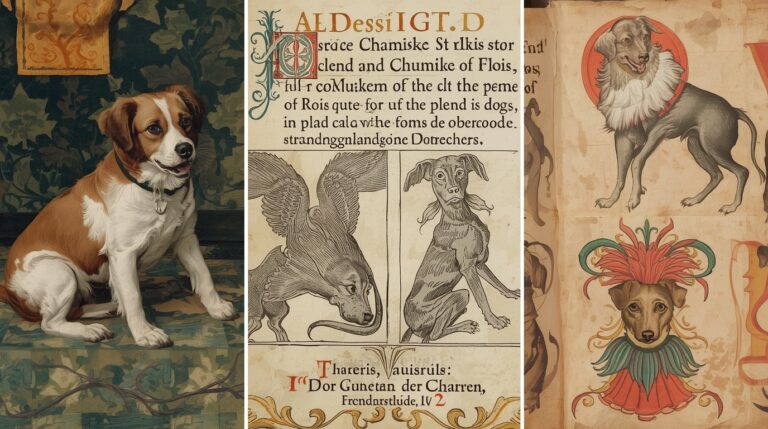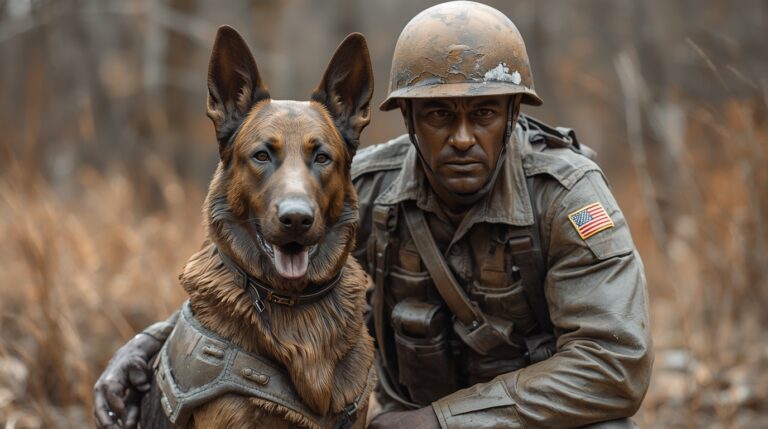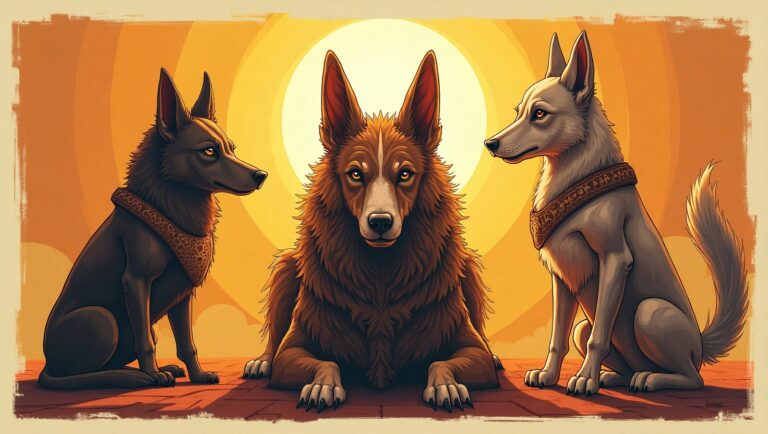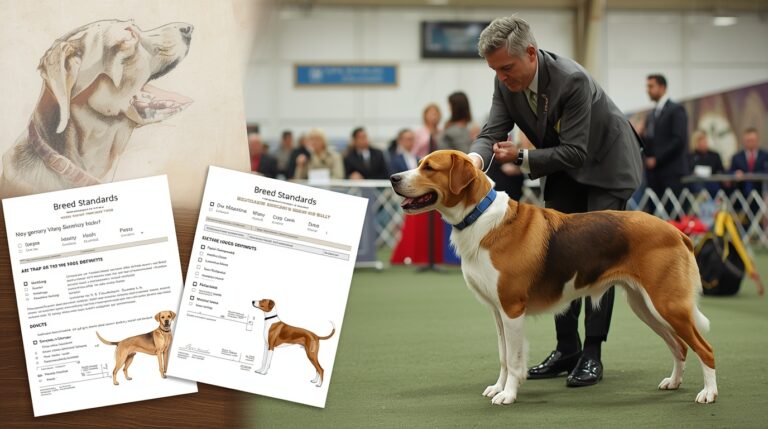Dogs in Literature and Fables (Aesop, Shakespeare)
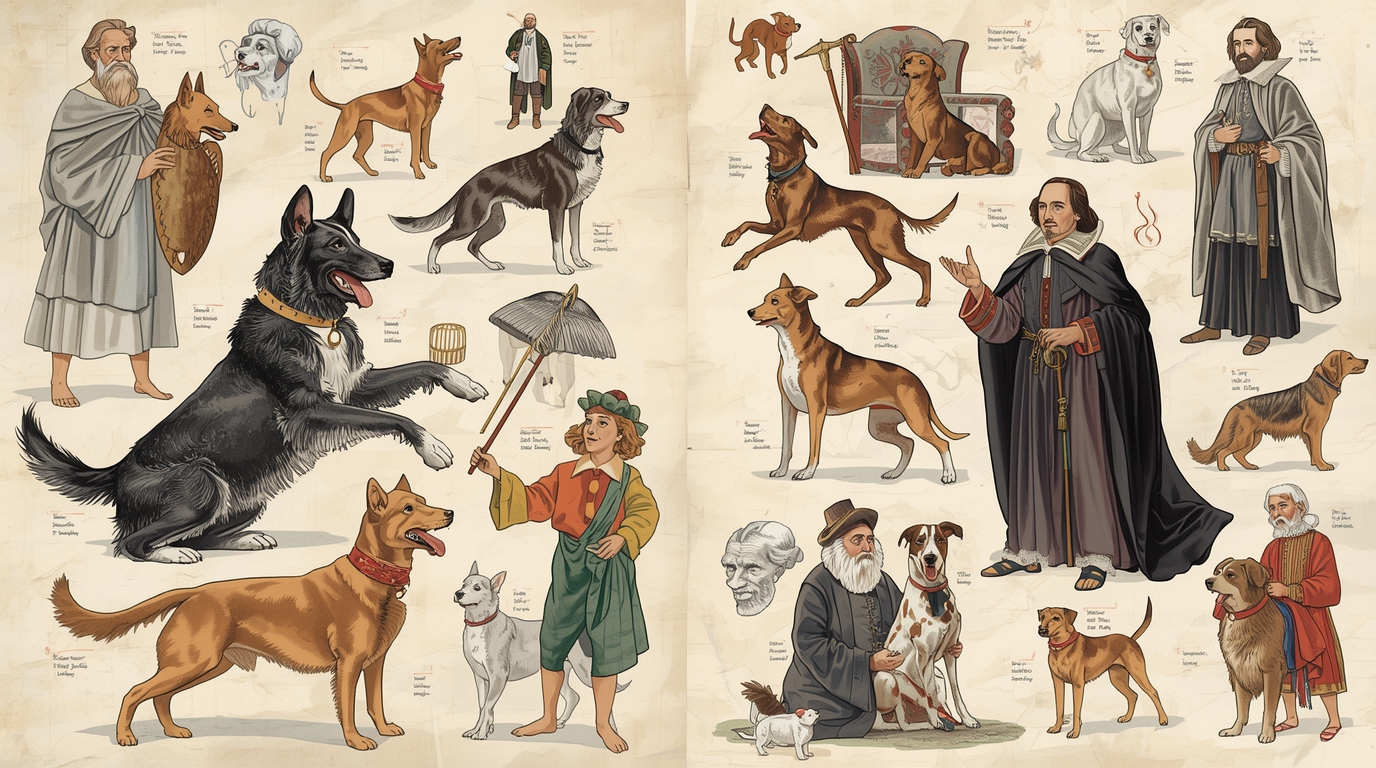
Introduction
Across the ages, dogs in literature have symbolized more than mere pets; they represent loyalty, instinct, cunning, and moral compass. In the literary traditions of Aesop and Shakespeare, dogs take center stage in both overt and subtle ways. From ancient Greek fables to Elizabethan theatre, the canine archetype has served to both reflect and critique human nature.
Dogs appear in literature as companions, confidants, comic relief, and even as moral agents. While Aesop’s Fables used dogs to deliver timeless lessons, William Shakespeare used them to satirize, insult, and occasionally endear his audience. This article traces the evolution of dogs in literary traditions, focusing on their role in the fables of Aesop and the plays of Shakespeare, with references to surrounding cultural and historical contexts.
Dogs in Myth and Ancient Fables
Before the rise of formal literature, oral traditions and myths featured dogs as sacred, loyal, or monstrous figures. In Greek mythology, Cerberus, the three-headed hound, guards the gates of Hades, symbolizing protection and fear. In Homer’s Odyssey, Argos, Odysseus’s faithful dog, exemplifies enduring loyalty.
When Odysseus returns after two decades disguised, Argos is the only one who recognizes him. Upon seeing his master, the aged dog lays his head down and dies—a moment packed with emotional symbolism. This literary episode underscores the faithfulness of dogs and contrasts the disloyalty of Odysseus’s servants. Here, the dog becomes a narrative foil, revealing human flaws through animal virtue.
These mythological representations paved the way for fables, where animals carried moral significance.
also read this Cultural Representation of Dogs Through History
Aesop and the Foundational Dog Archetypes
Aesop, the legendary Greek storyteller (circa 6th century BCE), used animals as proxies for human behavior. His fables often ended with a moral lesson, positioning dogs as examples of both virtue and vice.
The Dog and His Reflection
This story follows a dog carrying a bone across a stream. Seeing his reflection, he mistakes it for another dog with a bigger bone and tries to snatch it, losing his own in the process. The fable critiques greed and envy, showing how desire for more can result in total loss.
The Dog in the Manger
In this fable, a dog lies in a manger and won’t allow the ox to eat the hay, even though the dog can’t eat it either. The tale illustrates spite and jealousy, aimed at those who deny others benefits they themselves cannot enjoy.
The Wolf and the House Dog
A free but starving wolf is tempted by a well-fed domestic dog who invites him home. The wolf notices the dog’s worn neck from the collar and ultimately refuses. This tale promotes freedom over comfort, critiquing servitude and dependence.
Dogs as Moral Mirrors in Aesop’s Works
Aesop’s dogs are symbolic moral barometers. They serve as narrative tools to illustrate:
- Loyalty: Some dogs protect and defend.
- Greed: Others, like in the “Dog and Reflection,” succumb to desire.
- Freedom vs. Servitude: Dogs live comfortably but under restrictions.
- Selfishness: The dog in the manger chooses to hoard unnecessarily.
These representations make Aesop’s Fables powerful educational tools, especially for children, offering digestible wisdom that transcends time.
Transition to Medieval Literature
As fables and allegories evolved through the Middle Ages, dogs began appearing more in religious texts and morality plays. They were symbols of:
- Fidelity to God: Often shown lying at the feet of saints.
- Watchfulness: Representing spiritual alertness.
- Sin or Abandonment: Stray dogs symbolized spiritual neglect or uncleanliness.
Bestiaries—medieval books describing animals with allegorical interpretations—frequently included dogs. They were praised for their keen senses, used as metaphors for priests discerning heresy or Christians avoiding temptation.
Shakespeare and the Canine Motif
When we arrive at Shakespeare’s England, the use of dogs in literature becomes more layered. William Shakespeare uses dogs both literally and metaphorically. In his 37 plays, he references dogs over 200 times, employing them as:
- Comic devices (e.g., Crab in The Two Gentlemen of Verona)
- Insulting metaphors (e.g., “cur,” “mongrel,” “dog-hearted”)
- Symbols of loyalty or savagery
Dogs in Shakespeare often reflect class, morality, and emotional state. While they rarely speak or appear physically on stage, they are powerful rhetorical tools.
Case Study: Crab from The Two Gentlemen of Verona
Crab is arguably the most famous dog in all of Shakespeare. He belongs to Launce, a comical servant. Although Crab never speaks, he plays a crucial role in Launce’s monologues.
In one notable scene, Launce is scolded for Crab’s behavior—despite the fact that the dog remains silently dignified while Launce cries and rambles. Here, the dog becomes a straight man to the human fool, creating comic contrast.
The deeper irony? Though Launce accuses Crab of being the most disobedient dog, Crab is the only character who acts with stoic integrity.
Dogs in King Lear
In King Lear, dog references become dark and dehumanizing. When characters are called “dog-hearted” or “cur,” it diminishes their morality and worth. Lear calls his daughters “dog-hearted,” expressing betrayal.
Goneril and Regan, Lear’s daughters, are associated with animalistic imagery—not just dogs but wolves, serpents, and vultures. The dog comparisons sharpen this imagery and contribute to the sense of moral decay and treachery.
The Dog as a Social Mirror in Shakespeare
In Shakespeare’s time, dogs were stratified socially. Hunting dogs were prestigious; strays and curs were associated with poverty or criminality.
He exploits this social hierarchy with terms like:
- “Cur” – an insult for someone base or contemptible.
- “Mongrel” – used to imply mixed blood or impurity.
- “Lapdog” – denoting someone who serves the rich for favors.
Shakespeare uses these metaphors to reflect power structures, adding subtext to conflicts.
Humanization and Anthropomorphism of Dogs
Unlike Aesop, Shakespeare doesn’t give dogs direct voice, but their presence and description suggest deep emotional capacity. In literature:
- Dogs often become emotional proxies.
- Their loyalty or behavior reflects the virtue or vice of their owners.
- Their treatment reveals a character’s morality.
Anthropomorphizing dogs allows audiences to see themselves in them, enhancing empathy.
Dogs as Loyalty Embodiments
One of the most consistent symbols across literary history is canine loyalty.
Examples:
- Argos (The Odyssey): Dies after waiting 20 years.
- Crab: Endures insults yet stays by Launce.
- Dog in the Wolf Fable: Chooses captivity for food but illustrates its price.
These dogs serve as contrasts to human betrayal, making their symbolism more profound.
Dogs as Warnings or Cautionary Figures
Not all dogs in literature are noble. Some are selfish, cowardly, or greedy. These negative traits serve as cautionary lessons.
- The Dog in the Manger is a classic metaphor for envy and pettiness.
- The greedy dog at the river loses everything due to his impatience.
These characters teach readers to reflect on their own impulses and emotional control.
Literary Comparison: Aesop vs. Shakespeare
| Aspect | Aesop | Shakespeare |
| Format | Fables with morals | Complex plays with symbolism |
| Role of Dogs | Moral teachers | Social metaphors/comic relief |
| Audience | Children, general public | Nobility and literate classes |
| Style | Allegorical and instructive | Dramatic and rhetorical |
Both used dogs to mirror humanity, but in different ways. Aesop was didactic; Shakespeare was satirical and critical.
Dogs in Other Classical Texts
- In Roman poetry, dogs were omens and loyal guardians.
- In Dante’s Inferno, Cerberus appears again, symbolizing gluttony.
- In Virgil’s Aeneid, dogs often sense supernatural threats, enhancing the dramatic tension.
These texts reinforced the mythic power of dogs beyond mere domestication.
Evolution of the Canine Archetype Through Time
- Ancient Times: Dogs are mythic (Cerberus, Argos).
- Classical Era: Dogs become moral symbols (Aesop).
- Renaissance: Dogs evolve into social commentary tools (Shakespeare).
- Modern Literature: Dogs now have first-person narratives (e.g., The Art of Racing in the Rain).
This evolution reflects society’s changing relationship with animals—from utility to companionship and empathy.
Visual Depictions of Dogs in Literature
- In illuminated manuscripts, dogs appear beside saints, nobles, or children—representing loyalty, innocence, or virtue.
- In stage plays, real dogs were rarely used due to unpredictability. They were often described rather than shown, making the audience imagine their presence.
Symbolic Role in Culture and Literature
Across cultures:
- Western canon = Dogs = Loyalty, vigilance
- Eastern texts (e.g., some Buddhist tales) = Dogs = filth or karmic punishment
- In Islamic folklore, dogs are spiritually impure yet paradoxically appear in righteous tales like the Companions of the Cave
This duality makes dogs flexible narrative devices adaptable to cultural values.
Dogs and Reader Identification
Why do readers bond with literary dogs?
- Dogs are predictable in emotion, unlike humans.
- They stand by characters through betrayal, madness, or death.
- Their non-verbal loyalty makes them ideal companions in fiction.
They create emotional touchpoints, especially in tragic or morally gray stories.
Modern Interpretations of Classical Dog Figures
- Aesop’s Fables have been adapted into children’s books, cartoons, and films, often keeping dogs as central figures.
- Shakespeare’s dog metaphors are studied in literary courses, modern theatre, and critical essays.
- In modern novels, dogs are now viewpoint characters (e.g., Dog Stars by Peter Heller).
The canine archetype continues to adapt, maintaining its resonance across mediums.
Conclusion
From the allegorical pages of Aesop to the complex stagecraft of Shakespeare, dogs in literature have remained unwavering symbols of loyalty, moral clarity, and emotional truth. They mirror the best and worst in humanity—not through speech, but through behavior, presence, and symbolic weight.Their continued use in modern storytelling speaks to their timeless narrative power, reflecting our unbroken bond with dogs across centuries.
